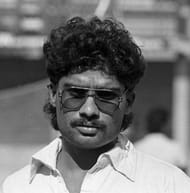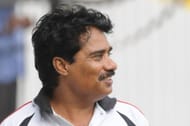Narendra Hirwani: Some of you might have heard of him as the one who registered a record match-haul of 16 wickets in his debut Test, against West Indies. The leg-spinner surpassed the then record for the best bowling figures on Test debut by a slender margin, conceding just a run less than Australia’s Bob Massie, who had figures of 16/137.
Early career
Making his First-class (FC) debut for Madhya Pradesh at the age of 16, the Gorakhpur-born registered his maiden five-wicket haul. A few fruitful outings with India Under-19 and Under-25 sides earned him a Test call-up, against the Caribbean side, Chennai, 1988.
With 8 wickets in each innings of the match, albeit in an under-prepared pitch, he announced his arrival at the international stage with a bang. It was followed by a Man-of-the-Series performance in the triangular One Day International tournament involving Sri Lanka and New Zealand at Sharjah in 1988. He was also the standout bowler in the home Test series against New Zealand later in that year. His performances, however, started to deteriorate as the novelty about him wore off.
India’s tour of England, 1990
Hirwani was now facing the heat following a series of mediocre shows in the longer format games overseas, in West Indies and New Zealand. In the first of the 3-match series in England, India went down quite easily, losing by a big margin of 247 runs, while a match-saving century from Sachin Tendulkar, which also happened to be his first international ton, and an unbeaten 160-run stand with Manoj Prabhakar ensured a draw in the second.
While his debut feat is well documented, a very few would have heard of his other notable record that might stand the test of time. The bowler delivered 59 overs without a break, not taking into consideration the session time-outs, in a Test match against England in 1990 at The Oval: the longest unbroken spell in Test match history.
In the series decider, the Mohammad Azharuddin-led side made best use of the pitch by amassing 606 for 9 dec., with Ravi Shastri(187) and Kapil Dev(110) scoring centuries. Prabhakar’s 4/74 closed out the England innings for 340 forcing the home side to follow on. It was only then the standy captain Ravi Shastri, and not Azharduddin who had to leave the field as a result of sore heel, decided to use Hirwani in such a long spell.
In an attempt to explore the footmarks on the pitch, Shastri persisted with Nirwani from the Vauxhall End in the second innings. The match all but slipped out of the hands when the strategy yielded just one wicket for 137 runs. 18 of those 59 six-ball overs delivered by the tireless leggie were maidens. The figures read 59-18-137-1. He was economical, yes, but it hardly mattered for the home side, as all they wanted was a stalemate to seal the series. Given the lack of penetration from one end, it was surprising that the visitors stuck to that tactic for such an extended period.
Eventually, England batted out 154 overs, scoring 477 runs for the loss of only 4 wickets, to earn a well-deserved draw. Interestingly, it was Shastri who was the captain of India when Hirwani made his debut.
It was in that innings that Graham Gooch went past Donald Bradman’s run tally of 6996 runs, before becoming Hirwani’s only victim.
The decline
Him being slower through the air coupled with the over dependability on the surface to aid his revolutions on the ball made him a lesser threat in years to come, and his decline also coincided with the emergence of Anil Kumble, who incidentally made his Test debut in the second match of the same tour. Kumble’s ability to extract more bounce at good pace on away decks made him an automatic choice since then.
After taking remedial measures as pointed out by Australian great Richie Benaud to rectify the issues with his delivery stride, he made a comeback in 1996. However, he wasn’t able to cement his place. With Harbhajan Singh’s rise and Kumle going on to take 619 international wickets, the door was permanently shut on the leggie.
Hirwani accounted for 732 FC wickets before his retirement in 2006: 23 years of cricket at the top level. His international career stretched across 8 years lasting 17 Tests and 18 ODIs, with 66 and 23 wickets respectively. He then served as a national selector representing central zone from 2008-2012.
Follow IPL Auction 2025 Live Updates, News & Biddings at Sportskeeda. Get the fastest updates on Mega-Auction and cricket news


